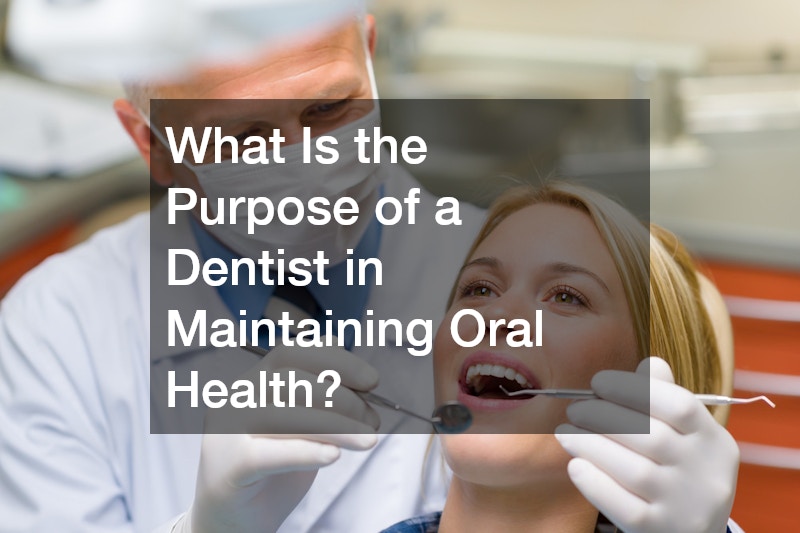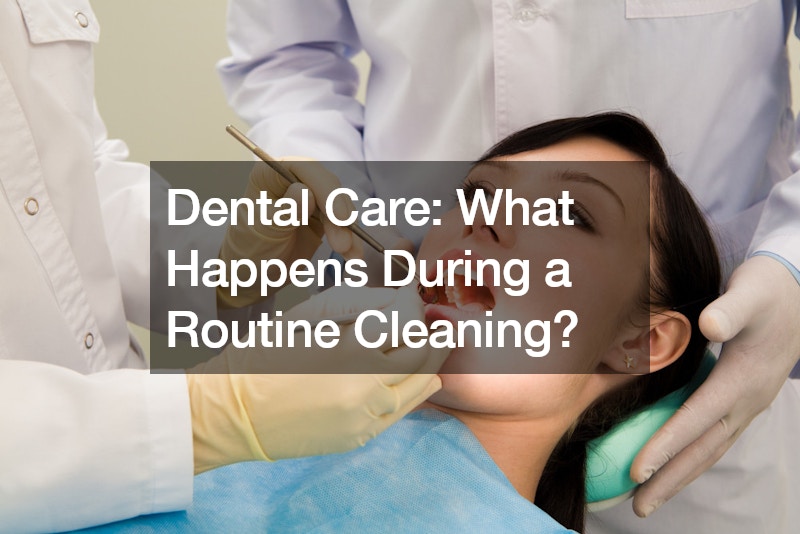
What Is the Purpose of a Dentist in Maintaining Oral Health?

Taking care of your mouth, teeth, and gums is a critical part of maintaining your overall health. From preventing painful infections to protecting your ability to eat and speak comfortably, professional oral care plays a foundational role in everyday well-being. While many people only think about dental appointments when there’s a problem, regular visits and a long-term care strategy are essential to catching issues early and preserving health over time. Oral care providers are highly trained in both prevention and treatment, helping individuals maintain strong teeth, healthy gums, and confident smiles.
This article explores the many functions of oral care professionals and how they support lifelong wellness. We’ll break down the topic into ten key areas that reflect the wide range of responsibilities these experts handle. Starting with the importance of regular checkups, we’ll discuss how ongoing visits can help stop small problems from becoming big ones. We’ll also take a look inside what typically happens during a routine visit and how those appointments contribute to a patient’s care journey.
From there, we’ll examine how oral care clinics serve not only as treatment centers but also as places where people can learn to care for their teeth and take action before problems arise. When issues do develop, like toothaches or deep infections, advanced procedures are often necessary to eliminate pain and preserve the tooth. Restorative solutions for damaged or broken teeth are another key focus, as they allow patients to maintain function and comfort even after injury or decay.
For those looking to improve their appearance, some specialists focus on enhancing the visual aspects of a smile. Meanwhile, others may need individualized treatment strategies designed to match their unique oral health goals. In urgent situations, some providers are available to handle time-sensitive or severe issues that can’t wait for a regular appointment. Others specialize in correcting alignment and bite problems to improve both form and function over time.
Finally, we’ll address the importance of selecting the right care provider for your needs, especially one located conveniently near home. By exploring each topic in depth, you’ll gain a clearer understanding of how oral health professionals protect and enhance overall well-being.
1. Why Checkups Matter
Maintaining a regular checkup schedule is a crucial part of protecting your oral health. These visits are about more than just cleaning teeth; they help identify minor issues before they become serious. A professional can monitor the condition of your gums, teeth, and jaw, making proactive decisions that save you time, money, and discomfort in the long run.
During a routine appointment, a dentist will evaluate your entire mouth using tools and techniques designed to catch things you might not notice. Whether it’s early-stage gum inflammation or the signs of grinding teeth, these assessments help build a full picture of your oral health. This process directly supports the overall purpose of a dentist: to prevent problems as much as to treat them.
Beyond the technical aspect, these visits are educational opportunities. Patients can ask questions about hygiene routines, get personalized advice, and receive treatment recommendations based on their unique needs. Over time, this consistent relationship builds a foundation for trust and optimal care.
2. Inside a Dental Visit

Walking into a care provider’s office can feel routine, but a lot is happening behind the scenes that contributes to maintaining your health. The structure of a visit is built around efficiency and thoroughness, ensuring that your mouth is checked, cleaned, and assessed for any potential risks.
In a typical dentist office, a hygienist will start with scaling and polishing to remove plaque and tartar buildup. Then, the professional steps in to conduct an in-depth exam. This can include visual checks, X-rays, and screening for oral cancer. Each component plays a part in catching issues early and delivering appropriate care.
The environment also matters. A welcoming, clean, and organized space allows patients to feel safe and relaxed. This setting supports the goal of encouraging regular visits, which are foundational to keeping problems at bay and supporting long-term wellness.
3. Prevention Starts Here
Oral health providers do more than react to dental emergencies; they are prevention specialists. The infrastructure of modern dental offices is built to support education, screening, and non-invasive treatments that help avoid more serious issues.
Inside these settings, professionals implement fluoride treatments, sealants, and deep cleanings. These actions are small but powerful steps that reflect the larger purpose of a dentist: to help patients avoid unnecessary pain and extensive procedures by staying ahead of potential problems.
This preventive approach extends to encouraging better habits. Clinics often provide materials and coaching to help people improve their brushing, flossing, and nutrition choices. Over time, these interventions have a lasting impact on individual and community health.
4. When Pain Means Action

Sharp or lingering tooth pain often signals a deeper problem beneath the surface. When the inner pulp of a tooth becomes infected, the most effective treatment is a root canal. While the procedure may sound intimidating, it plays a vital role in eliminating discomfort and preserving the tooth.
The root canal process involves removing the infected tissue, cleaning the canal, and sealing it to prevent further issues. It’s a clear example of the purpose of a dentist: providing relief while safeguarding the structure and function of your teeth.
This treatment not only stops the spread of infection but also prevents the need for an extraction. By preserving your natural tooth, your bite remains strong, your smile stays intact, and your overall health is protected from the risks of untreated infection.
5. Fixing Damaged Teeth
Sometimes teeth are too damaged for simple fillings to do the job. In such cases, dental crowns are used to protect and restore the tooth. These custom-made caps cover the entire visible portion of the tooth, offering strength, stability, and an improved appearance.
When a professional recommends a crown, it’s because the tooth has often undergone significant decay, cracking, or has been treated with a root canal. Placing a crown is part of the purpose of a dentist: to restore function and help patients keep their natural teeth for as long as possible.
Modern crown materials are highly durable and designed to blend in naturally with the surrounding teeth. The placement process is typically painless and ensures long-term protection against further damage.
6. Enhancing Your Smile

Not all dental work is done for medical reasons; sometimes it’s about helping people feel more confident in their appearance. Those who specialize in cosmetic procedures focus on making aesthetic improvements that still contribute to overall oral health.
A cosmetic dentist can whiten teeth, close gaps, and even reshape or align individual teeth for a more uniform smile. These treatments help individuals not only look better but also feel better about themselves. This, too, ties into the purpose of a dentist: supporting both physical wellness and emotional well-being.
By improving the visual aspect of a smile, these professionals often boost self-esteem and quality of life. A beautiful smile can influence social interactions, professional opportunities, and daily confidence.
7. Choosing the Right Plan
No two mouths are the same, which means oral care must be tailored to the individual. Developing a custom dental treatment plan allows providers to address the unique needs, challenges, and goals of each patient.
Whether someone needs restorative care, aesthetic improvements, or management of a chronic condition, the right strategy makes all the difference. It shows the purpose of a dentist in action: crafting care that is both effective and personal.
Over time, these personalized plans build trust between the patient and provider. They also help patients stay committed to their oral health by offering realistic, achievable steps toward improvement.
8. Responding to Urgencies

Dental emergencies don’t wait for business hours. Accidents, severe pain, or infections can strike suddenly, requiring prompt attention. Having access to an emergency dentist ensures that critical care is available when it’s needed most.
These professionals handle situations such as knocked-out teeth, abscesses, or trauma-related damage. Their fast response and ability to act quickly is another reflection of the purpose of a dentist: to relieve suffering and prevent worsening conditions.
By addressing urgent problems immediately, they help protect both oral health and overall health. The availability of emergency care can make a major difference in outcomes and recovery time.
9. Straightening Solutions
Straight teeth aren’t just about looks; they’re essential to long-term health. Professionals who focus on alignment issues specialize in repositioning teeth and correcting bite problems for better function and aesthetics.
An orthodontist can diagnose issues early and develop a treatment plan that may include braces, clear aligners, or other appliances. This proactive care supports the larger purpose of a dentist: ensuring that every part of the mouth works as it should.
Proper alignment helps prevent jaw pain, tooth wear, and hygiene difficulties. Over time, a corrected bite can make eating, speaking, and cleaning your teeth much easier.
10. Finding Nearby Help
Convenience matters when it comes to maintaining health. Being able to visit a local dentist office encourages regular appointments and timely care, making it easier to stay on top of oral hygiene.
Choosing a nearby provider also means quicker access in case of urgent needs, easier scheduling, and a better chance of maintaining consistency in care. This local availability supports the purpose of a dentist: making sure help is always within reach.
Familiarity with a local team builds long-term relationships, increases trust, and improves continuity of care. It also encourages families to stay engaged in their oral health routines.
Oral health is a vital component of your overall wellness, and maintaining it requires more than just brushing and flossing. Professional care ensures that your teeth, gums, and jaw stay healthy through every stage of life. From prevention to emergency response, cosmetic enhancements to restorative procedures, each service supports a unified goal.
The purpose of a dentist is multifaceted: to diagnose and treat problems, educate patients, provide relief, and help preserve your natural teeth for as long as possible. Regular visits, personalized care plans, and access to local and emergency services all contribute to a comprehensive approach that protects and enhances your quality of life.
Throughout this guide, we’ve explored ten essential roles played by oral care professionals. Whether you’re managing daily hygiene, seeking aesthetic improvements, or recovering from injury, the support of a skilled provider is irreplaceable. They do more than treat teeth; they empower you to maintain lifelong health and confidence.
Understanding what goes into oral care helps demystify the process and encourages active participation in your well-being. By recognizing the wide range of services and the thoughtful planning behind each visit, you can make more informed decisions and appreciate the essential role these professionals play.
What is the purpose of a dentist in maintaining oral health? It’s to be a dedicated partner in your health journey, ensuring that your smile stays strong, your mouth stays pain-free, and your overall health benefits from expert, compassionate care.


